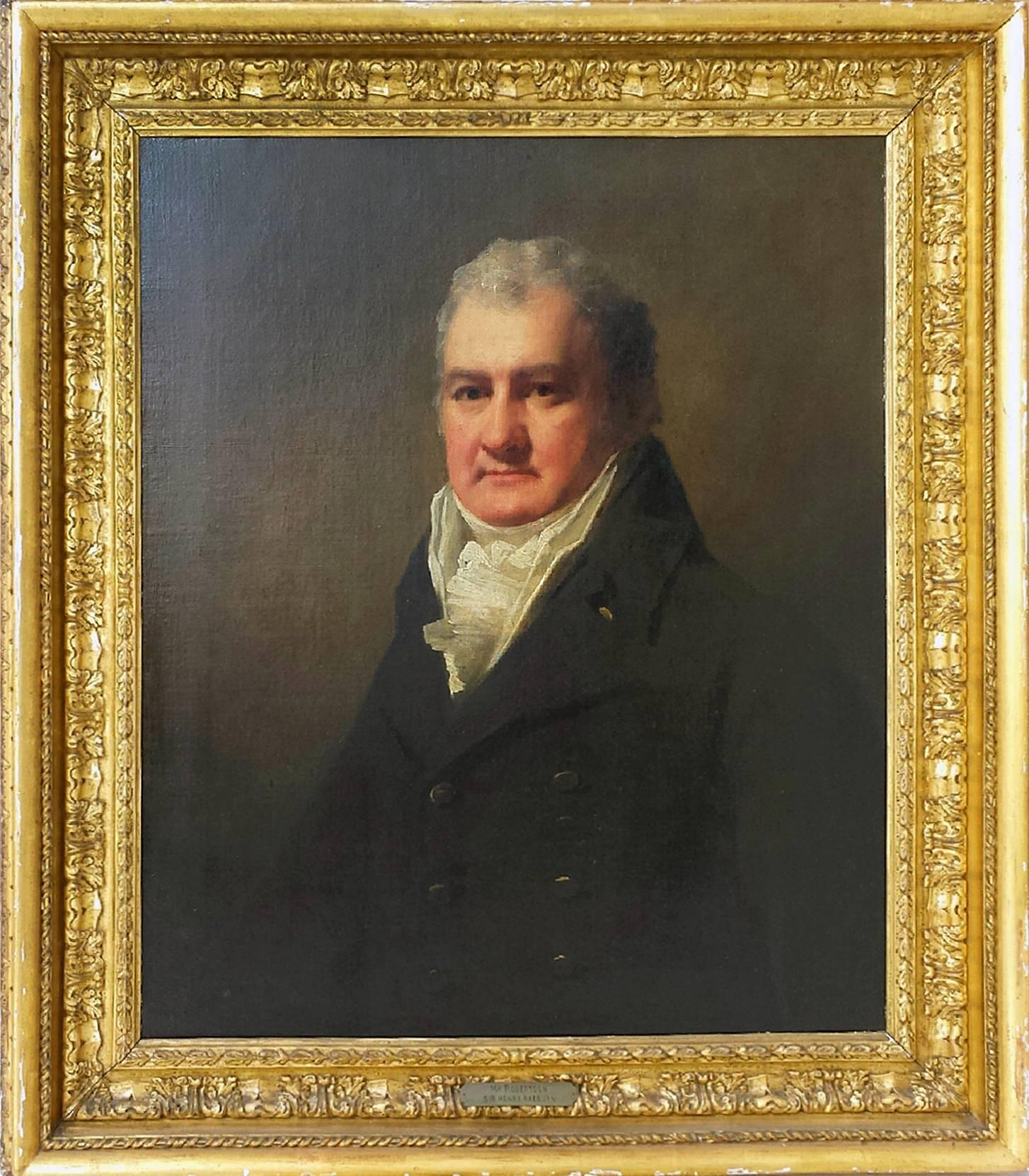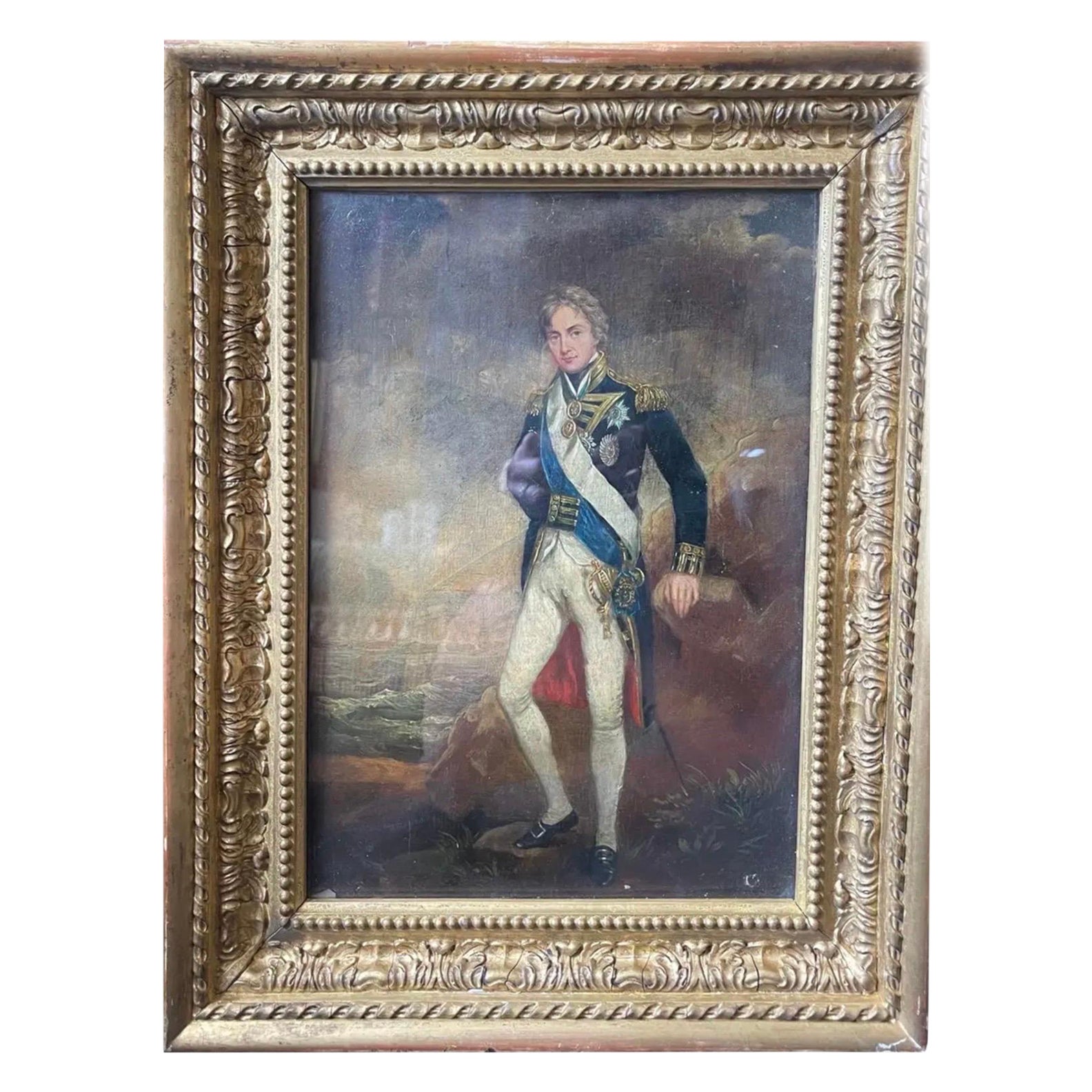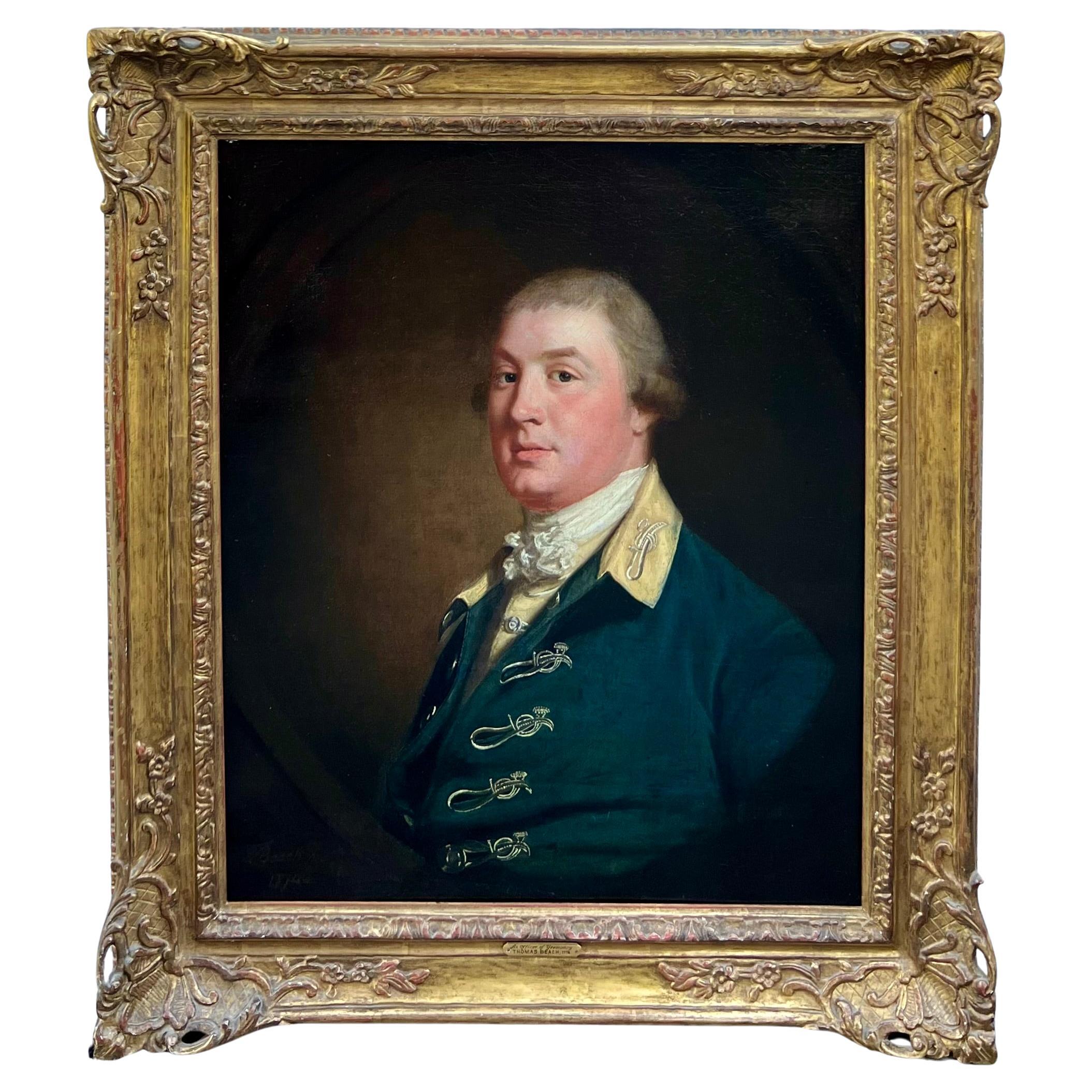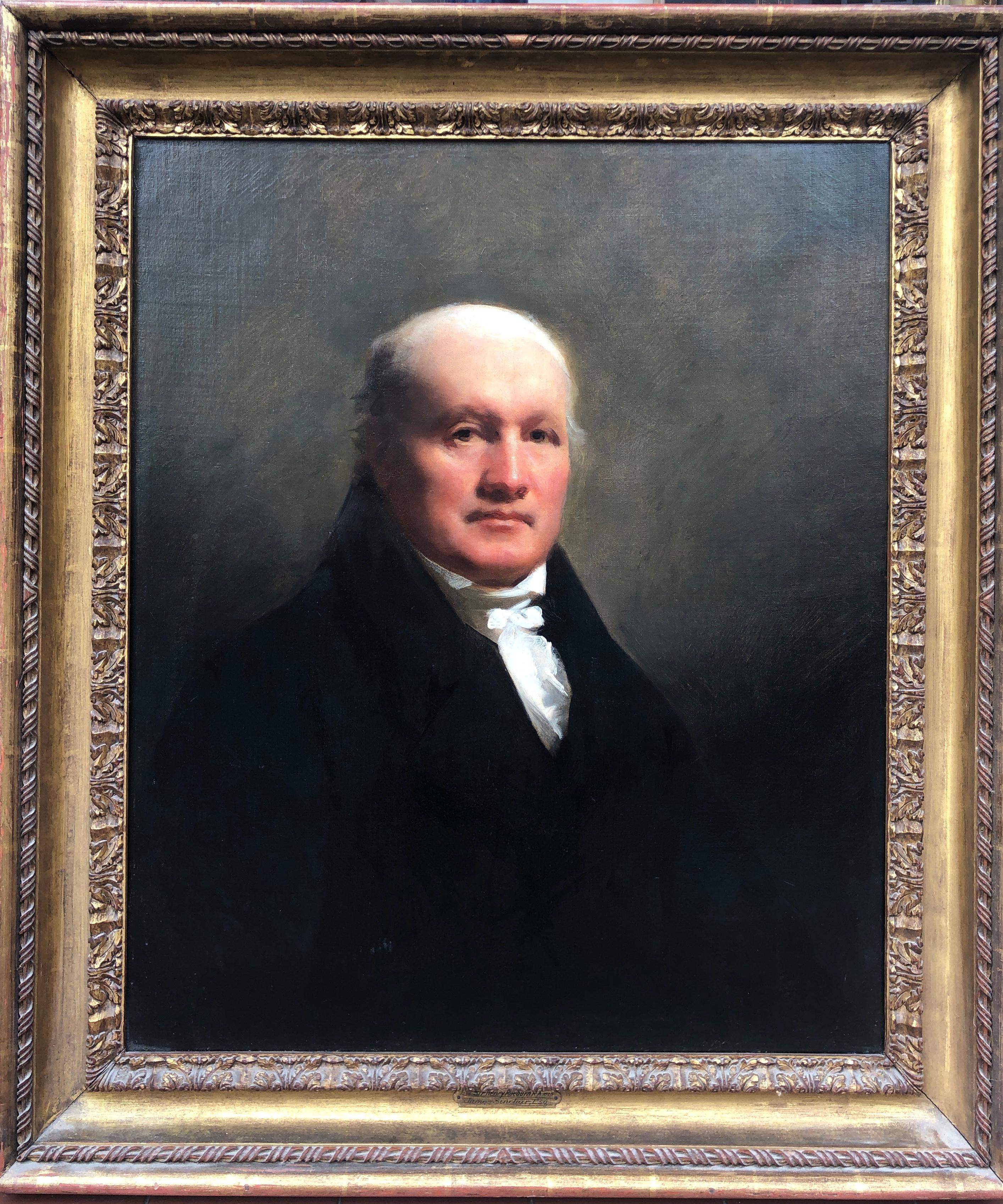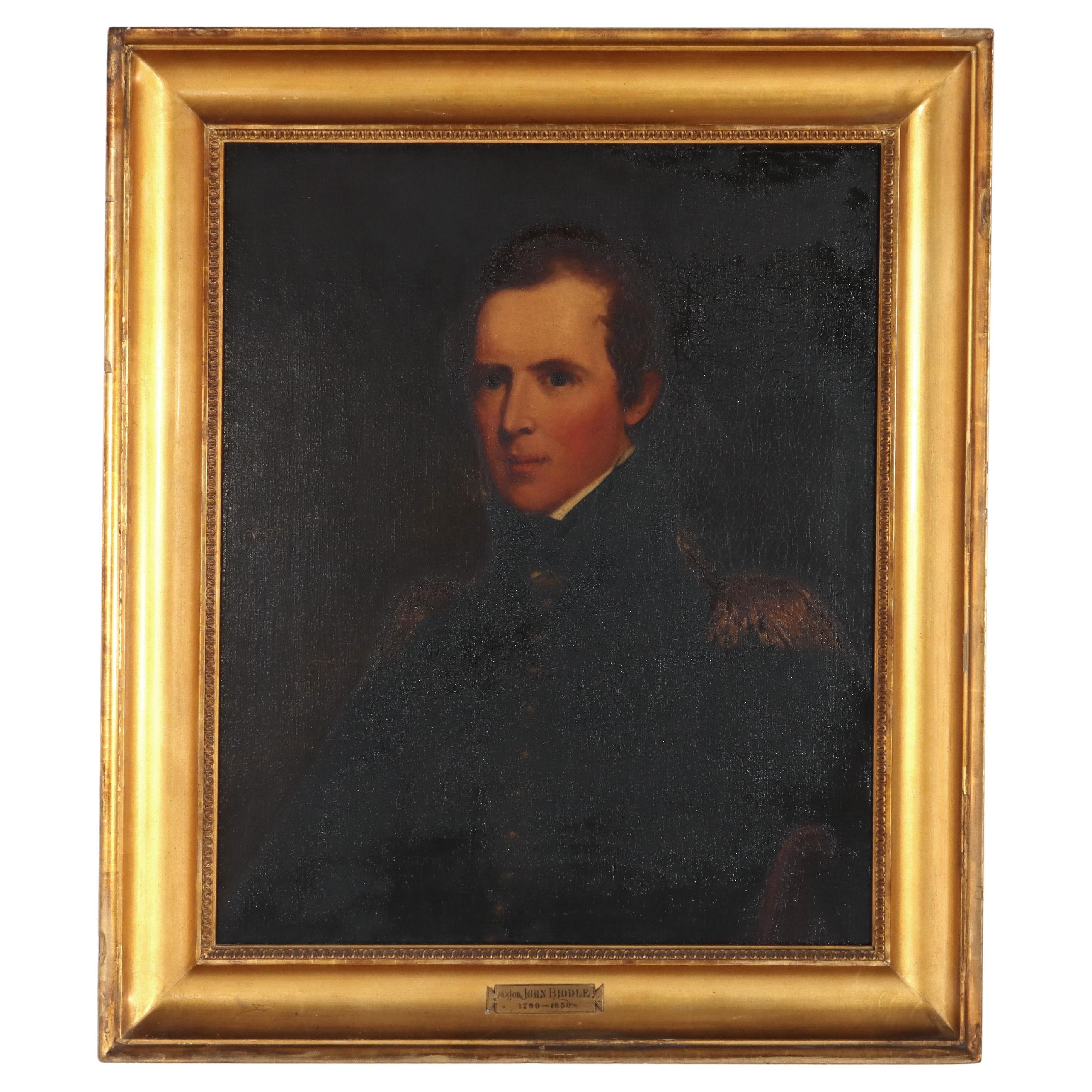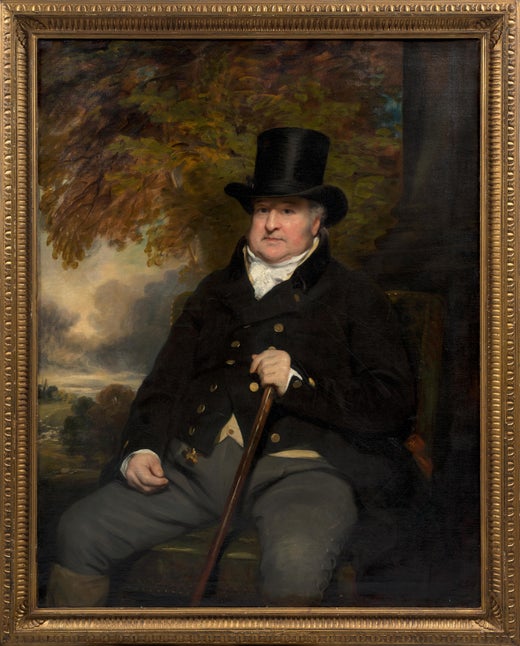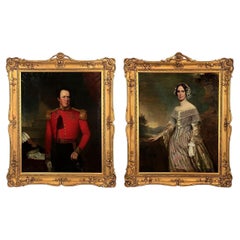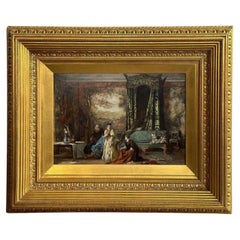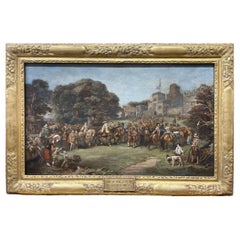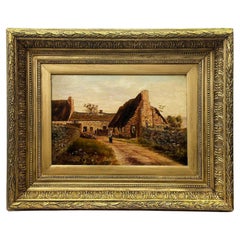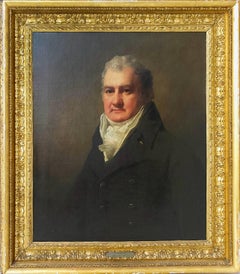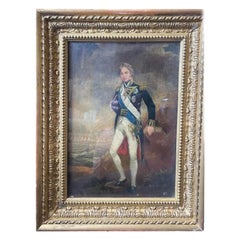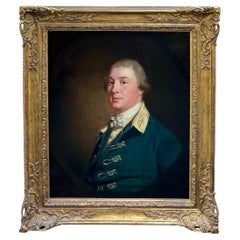Items Similar to Monumental Portrait of Lt. General Hay MacDowall by Sir Henry Raeburn, 1805–1815
Want more images or videos?
Request additional images or videos from the seller
1 of 8
Monumental Portrait of Lt. General Hay MacDowall by Sir Henry Raeburn, 1805–1815
$46,000
£34,944.51
€40,250.51
CA$65,807.65
A$72,173.52
CHF 37,222.90
MX$862,173.77
NOK 472,099.66
SEK 442,883.04
DKK 300,700.90
About the Item
An extraordinary and monumental oil on canvas portrait by renowned Scottish artist Sir Henry Raeburn (1756–1823), depicting Lieutenant General Hay MacDowall in full military regalia. Painted circa 1805–1815 and presented in a finely carved gilt wood frame, this commanding life-size portrait captures the stature and heroic bearing of the British officer.
The low-angle perspective enhances the General's prominence, elevating him to a near-mythic figure. His uniform, worn during his time with the 57th Regiment of Foot (1791–1795), provides a precise timeframe for the subject’s depiction. It is likely this portrait was commissioned to mark his departure from the regiment in 1795 before he assumed command in Madras, India, where his tenure was met with controversy and ultimately ended in tragedy. General MacDowall drowned in a shipwreck off the Cape of Good Hope while returning to England.
This exceptional portrait is a rare historical artifact, embodying the grandeur and artistic mastery of early 19th-century British military portraiture. A masterpiece for institutions, collectors of military history, or connoisseurs of museum-grade portraiture.
Dimensions: **MODEL HEIGHT REFERENCE ON THE FOURTH PICTURE IS 6' FT TALL**
* Height: 108 in. (274.32 cm)
* Width: 72 in. (182.88 cm)
* Depth: 4 in. (10.16 cm)
Details:
* Artist: Sir Henry Raeburn
* Origin: Scotland
* Year: c. 1805–1815
* Style: Neoclassical / Historical Portraiture
- Creator:Sir Henry Raeburn (Artist)
- Dimensions:Height: 108 in (274.32 cm)Width: 72 in (182.88 cm)Depth: 4.5 in (11.43 cm)
- Materials and Techniques:
- Place of Origin:
- Period:
- Date of Manufacture:Early 19th Century
- Condition:Wear consistent with age and use.
- Seller Location:Los Angeles, CA
- Reference Number:Seller: PGD000272901stDibs: LU818845828562
Sir Henry Raeburn
Sir Henry Raeburn, FRSE, RA, RSA (1756–1823) was a prominent Scottish portrait painter who is now largely credited for the revival of Scottish art in the early 19th century. Born in Stockbridge, Edinburgh, he was orphaned at a young age and subsequently educated at Heriot’s Hospital. He began his career as a goldsmith's apprentice, creating portrait miniatures before transitioning to oil painting, largely self-taught. Raeburn married the wealthy Ann Edgar, which enabled him to study art in Italy, where he was advised by Sir Joshua Reynolds and others. Upon returning to Edinburgh in 1787, Raeburn quickly gained success, painting notable figures like Sir Walter Scott and Dugald Stewart. He became known for his vigorous brushwork, strong characterizations, and dramatic lighting. His direct painting style and refusal to make preparatory sketches set him apart from contemporaries, incorporating elements of Romanticism. He was knighted by King George IV in 1822 and appointed the King’s limner for Scotland. He died in 1823 at his home in Stockbridge, Edinburgh. This distinguished three-quarter length portrait depicts Elizabeth Clough (b. circa 1970-1770s), matriarch of the Clough family of Keighley, West Yorkshire. The piece was commissioned by her son, John Clough (1799–1863), a prominent engineer and industrialist in Keighley. Clough owned and operated Grove Mills, a major worsted spinning and manufacturing facility which employed a significant portion of the local workforce. Elizabeth Clough is portrayed seated in an upholstered armchair, dressed in sober but elegant attire—a dark shawl and a crisp white cap tied beneath her chin. Her direct, steady gaze and flushed cheeks convey quiet strength and maternal dignity. The subdued, neutral background serves to emphasize the face and upper body, while still maintaining an airy and light feel. The face is rendered with sensitive modeling and naturalistic lighting, while the fabric of her garments contain blockier brushstrokes yet do not lose their sensitivity. These characteristics, combined with the information gleaned from the label, place this piece in the tradition of early 19th century Scottish portraiture.
About the Seller
4.9
Platinum Seller
Premium sellers with a 4.7+ rating and 24-hour response times
Established in 1999
1stDibs seller since 2006
417 sales on 1stDibs
Typical response time: 2 hours
Associations
20th Century Specialists
- ShippingRetrieving quote...Shipping from: Los Angeles, CA
- Return Policy
Authenticity Guarantee
In the unlikely event there’s an issue with an item’s authenticity, contact us within 1 year for a full refund. DetailsMoney-Back Guarantee
If your item is not as described, is damaged in transit, or does not arrive, contact us within 7 days for a full refund. Details24-Hour Cancellation
You have a 24-hour grace period in which to reconsider your purchase, with no questions asked.Vetted Professional Sellers
Our world-class sellers must adhere to strict standards for service and quality, maintaining the integrity of our listings.Price-Match Guarantee
If you find that a seller listed the same item for a lower price elsewhere, we’ll match it.Trusted Global Delivery
Our best-in-class carrier network provides specialized shipping options worldwide, including custom delivery.More From This Seller
View AllTwo 19th Century Portraits of a British Officer & Lady in Gilt Frames, England.
Located in Los Angeles, CA
A distinguished set of two 19th century Continental oil on canvas portraits, depicting an important British military officer in full dress uniform and a refined lady posed in a forma...
Category
Antique 19th Century English Paintings
Materials
Canvas
British Framed Painting by Laslett John Pott, 1876
Located in Los Angeles, CA
Beautiful antique oil on panel depicting Amy Robsart having her wedding dress shown in her master bedroom. It is protected by a gilt wood frame. Signed "Laslett J. Pott" and dated 18...
Category
Antique 1870s British Paintings
Materials
Giltwood, Paint
18th C. Painting on Canvas of King James I Visit to Hoghton Tower
Located in Los Angeles, CA
This exquisite 18th-century oil painting captures the historic moment of King James I visit to Hoghton Tower during his return from Scotland on August 15, 1617. The scene is richly d...
Category
Antique 18th Century English Paintings
Materials
Canvas
British Late 19th Century Framed Oil on Canvas
Located in Los Angeles, CA
Serene oil on canvas depicting a small cottage with a lady standing on the little path. The art piece was made in the United Kingdom in the Late 19th Century and includes original gi...
Category
Antique Late 19th Century British Paintings
Materials
Canvas, Giltwood, Paint
Oil on Canvas Landscape by Charles Leslie, 1878
By Charles Leslie
Located in Los Angeles, CA
19th Century oil on canvas landscape by Charles Leslie, a great English painter in the Victorian era. It is framed with a beautiful giltwood fram...
Category
Antique 1870s British Paintings
Materials
Canvas, Wood, Paint
Belle Époque Portraits of Louis XVI & Marie Antoinette by Jean-Gothard Muller.
Located in Los Angeles, CA
A magnificent and historically rich pair of Belle Époque portraits depicting King Louis XVI and Queen Marie Antoinette, created by celebrated French engraver Jean-Gothard Muller in t...
Category
Antique Early 19th Century French Antiquities
Materials
Paper
You May Also Like
Henry MacBeth Raeburn RA RE (1860-1947) - Mezzotint, General Hay MacDowall
Located in Corsham, GB
A charming mezzontint after the portrait by Henry MacBeth Raeburn depicting General Hay MacDowall. Hay MacDowall was a Scottish officer in the British Army who was the sixth General ...
Category
Early 20th Century Portrait Prints
Materials
Mezzotint
Half Length Portrait of Mr. Robertson of Edinburgh
By Sir Henry Raeburn
Located in Miami, FL
Half Length Portrait of Mr. Robertson
Sir. Henry Raeburn ( Scottish 1756 - 1823 )
Half Length Portrait of Mr. Robertson
29x 24
Purchased, J Leger & Son,...
Category
18th Century Realist Portrait Paintings
Materials
Oil
Oil on Wood Depicting Amiral Horatio Nelson in Military Costume England 19th
Located in palm beach, FL
Oil on wood depicting Amiral Horatio Nelson, 1st Viscount Nelson, Duke of Bronte, born September 29, 1758 at Burnham Thorpe and died October 21, 1805 off Cape Trafalgar, is a British...
Category
Antique Late 19th Century British Paintings
Materials
Paint
"Portrait of a British Officer" by Thomas Beach
By Thomas Beach
Located in Wiscasset, ME
A very fine portrait of a British military officer signed and dated Thomas Beach 1774 in the lower left. This oil on canvas is presented in a period gilt frame and is ready to hang....
Category
Antique 1770s English American Colonial Paintings
Materials
Paint
Striking 18th Century Portrait of the 12th Earl of Caithness
By Sir Henry Raeburn
Located in London, GB
Sir Henry Raeburn (1756-1823)
James Sinclair, 12th Earl of Caithness (1766-1823)
Oil on Canvas
30 X 25 inches Unframed
37 X 32 inches framed
Sir Henry Raeburn FRSE RA RSA (4 March 1756 – 8 July 1823) was a Scottish portrait painter and Scotland's first significant portrait painter since the Union to remain based in Scotland. He served as Portrait Painter to King George IV in Scotland.
Raeburn was born the son of a manufacturer in Stockbridge, on the Water of Leith: a former village now within the city of Edinburgh. He had an older brother, born in 1744, called William Raeburn. His ancestors were believed to have been soldiers, and may have taken the name "Raeburn" from a hill farm in Annandale, held by Sir Walter Scott's family. Orphaned, he was supported by William and placed in Heriot's Hospital, where he received an education. At the age of fifteen he was apprenticed to the goldsmith James Gilliland of Edinburgh, and various pieces of jewellery, mourning rings and the like, adorned with minute drawings on ivory by his hand, still exist. Soon he took to the production of carefully finished portrait miniatures; meeting with success and patronage, he extended his practice to oil painting, at which he was self-taught. Gilliland watched the progress of his pupil with interest, and introduced him to David Martin, who had been the favourite assistant of Allan Ramsay the Latter, and was now the leading portrait painter in Edinburgh. Raeburn was especially aided by the loan of portraits to copy. Soon he had gained sufficient skill to make him decide to devote himself exclusively to painting. George Chalmers (1776; Dunfermline Town Hall) is his earliest known portrait.
In his early twenties, Raeburn was asked to paint the portrait of a young lady he had noticed when he was sketching from nature in the fields. Ann was the daughter of Peter Edgar of Bridgelands, and widow of Count James Leslie of Deanhaugh. Fascinated by the handsome and intellectual young artist, she became his wife within a month, bringing him an ample fortune. The acquisition of wealth did not affect his enthusiasm or his industry, but spurred him on to acquire a thorough knowledge of his craft. It was usual for artists to visit Italy, and Raeburn set off with his wife. In London he was kindly received by Sir Joshua Reynolds, the president of the Royal Academy, who advised him on what to study in Rome, especially recommending the works of Michelangelo, and gave Raeburn letters of introduction for Italy. In Rome he met his fellow Scot Gavin Hamilton, Pompeo Girolamo Batoni and Byers, an antique dealer whose advice proved particularly useful, especially the recommendation that "he should never copy an object from memory, but, from the principal figure to the minutest accessory, have it placed before him." After two years of study in Italy he returned to Edinburgh in 1787, and began a successful career as a portrait painter. In that year he executed a seated portrait of the second Lord President Dundas.
Examples of his earlier portraiture include a bust of Mrs Johnstone of Baldovie and a three-quarter-length of Dr James Hutton: works which, if somewhat timid and tentative in handling and not as confident as his later work, nevertheless have delicacy and character. The portraits of John Clerk, Lord Eldin, and of Principal Hill of St Andrews belong to a later period. Raeburn was fortunate in the time in which he practised portraiture. Sir Walter Scott, Hugh Blair, Henry Mackenzie, Lord Woodhouselee, William Robertson, John Home, Robert Fergusson, and Dugald Stewart were resident in Edinburgh, and were all painted by Raeburn. Mature works include his own portrait and that of the Rev. Sir Henry Moncrieff Wellwood, a bust of Dr Wardrop of Torbane Hill, two full-lengths of Adam Rolland of Gask, the remarkable paintings of Lord Newton and Dr Alexander Adam in the National Gallery of Scotland, and that of William Macdonald of St Martin's. Apart from himself, Raeburn painted only two artists, one of whom was Sir Francis Leggatt Chantrey, the most important and famous British sculptor of the first half of the 19th century. It has recently been revealed that Raeburn and Chantrey were close friends and that Raeburn took exceptional care over the execution of his portrait of the sculptor, one of the painter's mature bust-length masterpieces.
It was commonly believed that Raeburn was less successful in painting female portraits, but the exquisite full-length of his wife, the smaller likeness of Mrs R. Scott Moncrieff in the National Gallery of Scotland, and that of Mrs Robert Bell, and others, argue against this. Raeburn spent his life in Edinburgh, rarely visiting London, and then only for brief periods, thus preserving his individuality. Although he, personally, may have lost advantages resulting from closer association with the leaders of English art, and from contact with a wider public, Scottish art gained much from his disinclination to leave his native land. He became the acknowledged chief of the school which was growing up in Scotland during the early 19th century, and his example and influence at a critical period were of major importance. So varied were his other interests that sitters used to say of him, "You would never take him for a painter till he seizes the brush and palette."
In 1812 he was elected president of the Society of Artists in Edinburgh; and in 1814 associate, and in the following year full member, of the Royal Scottish Academy. On 29 August 1822 he was knighted by George IV and appointed His Majesty's limner for Scotland at the Earl of Hopetoun house. He died in Edinburgh.
Raeburn had all the essential qualities of a popular and successful portrait painter. He was able to produce a telling and forcible likeness; his work is distinguished by powerful characterisation, stark realism, dramatic and unusual lighting effects, and swift and broad handling of the most resolute sort. David Wilkie recorded that, while travelling in Spain and studying the works of Diego Velázquez, the brushwork reminded him constantly of the "square touch" of Raeburn. Scottish physician and writer John Brown wrote that Raeburn "never fails in giving a likeness at once vivid, unmistakable and pleasing. He paints the truth, and he paints it with love".
Raeburn has been described as a "famously intuitive"portrait painter. He was unusual amongst many of his contemporaries, such as Reynolds, in the extent of his philosophy of painting directly from life; he made no preliminary sketches. This attitude partly explains the often coarse modelling and clashing colour combinations he employed, in contrast to the more refined style of Thomas Gainsborough and Reynolds. However these qualities and those mentioned above anticipate many of the later developments in painting of the 19th century from romanticism to Impressionism.
Sir Henry Raeburn died in St Bernard's House (17 St Bernards Crescent), Stockbridge, Edinburgh. He is buried in St. Cuthbert's churchyard against the east wall (the monument erected by Raeburn in advance) but also has a secondary memorial in the Church of St John the Evangelist, Edinburgh.
James Sinclair, 12th Earl of Caithness was born at Barrogill Castle (Castle of Mey) on 31 May 1766. He was the son of Sir John Sinclair of Mey, Baronet who he succeeded in the baronetcy in 1774. He succeeded as 12th earl of Caithness in 1789.
He was lord-lieutenant of the county of Caithness and lieutenant-colonel of the Ross-shire militia.
He married at Thurso Castle on 2 January 1784 Jane, second daughter of Alexander Campbell...
Category
18th Century Portrait Paintings
Materials
Oil
$29,582 Sale Price
40% Off
Free Shipping
Large Antique Oil On Canvas Portrait Painting of Major John Biddle Unsigned 1818
Located in Big Flats, NY
Large Antique Oil On Canvas Portrait Painting of Major John Biddle Unsigned 1818.
Measures - 36 1/2" x 31 1/2" x 3".
An antique oil on canvas painting depicting Major John B...
Category
Antique Early 19th Century Paintings
Materials
Canvas
$1,480 Sale Price
20% Off
More Ways To Browse
Antique Uniforms
Cape Of Good Hope
Madras India
Used Mirrored Bedroom Furniture
Vintage Chrome Furniture
Orange Furniture
Meridienne Or Recamier
Modern Glass Chandeliers
Vintage 1969 Glass
Dining Chairs Chairs
Used Coffee Table Coffee Tables
Paris France
Indian Carpets
Danish Modern Dining Room Furniture
Used Leather Living Room Furniture
Turn Of The Century Furniture
Antique Edger
Mid Century Ceramics

